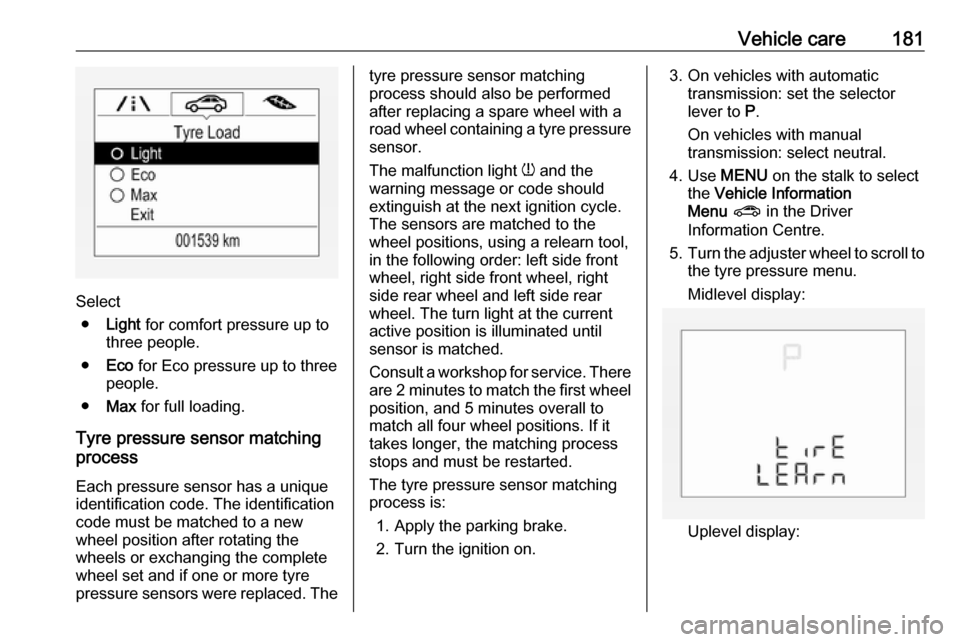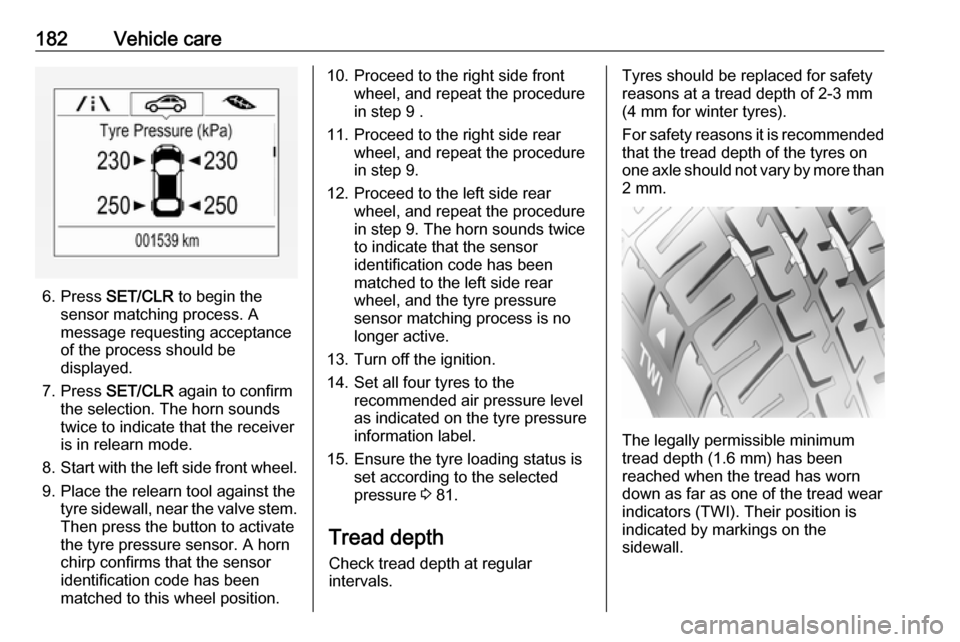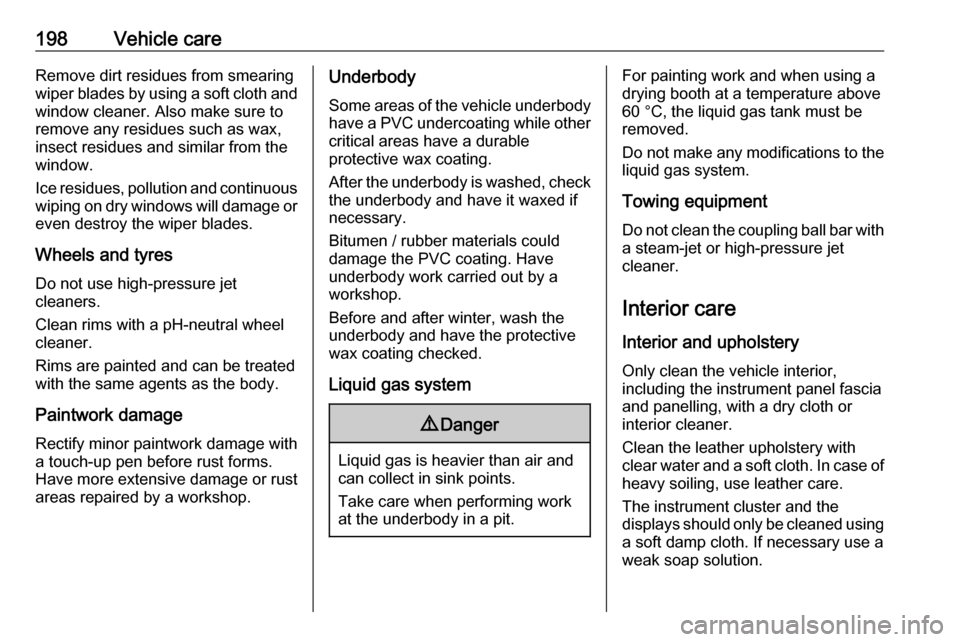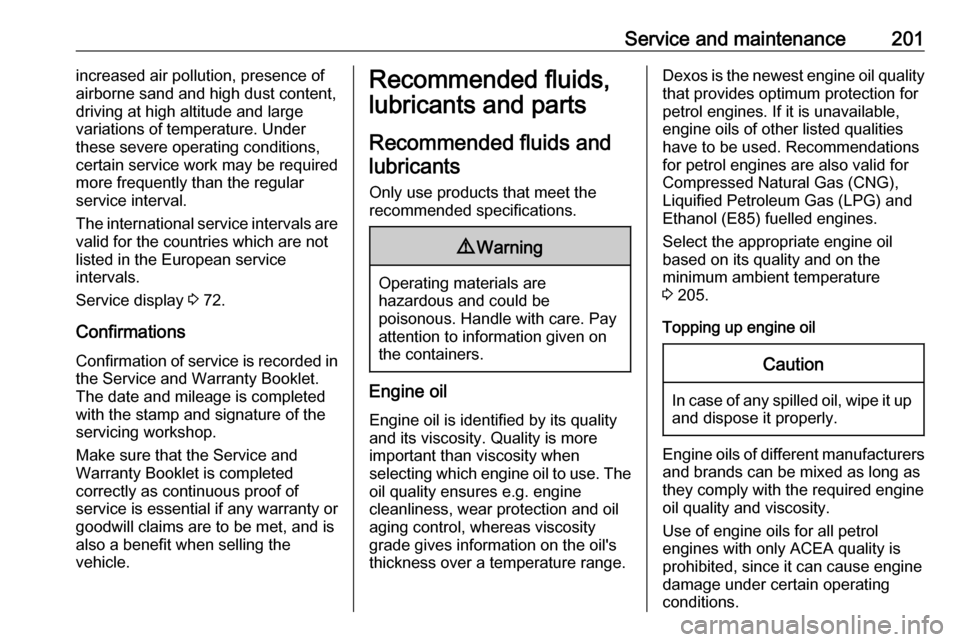display VAUXHALL CORSA F 2019 Repair Manual
[x] Cancel search | Manufacturer: VAUXHALL, Model Year: 2019, Model line: CORSA F, Model: VAUXHALL CORSA F 2019Pages: 229, PDF Size: 6.72 MB
Page 183 of 229

Vehicle care181
Select● Light for comfort pressure up to
three people.
● Eco for Eco pressure up to three
people.
● Max for full loading.
Tyre pressure sensor matching process
Each pressure sensor has a unique identification code. The identification
code must be matched to a new
wheel position after rotating the
wheels or exchanging the complete
wheel set and if one or more tyre
pressure sensors were replaced. The
tyre pressure sensor matching
process should also be performed
after replacing a spare wheel with a
road wheel containing a tyre pressure
sensor.
The malfunction light w and the
warning message or code should
extinguish at the next ignition cycle.
The sensors are matched to the
wheel positions, using a relearn tool,
in the following order: left side front
wheel, right side front wheel, right
side rear wheel and left side rear
wheel. The turn light at the current
active position is illuminated until
sensor is matched.
Consult a workshop for service. There are 2 minutes to match the first wheel
position, and 5 minutes overall to
match all four wheel positions. If it
takes longer, the matching process
stops and must be restarted.
The tyre pressure sensor matching
process is:
1. Apply the parking brake.
2. Turn the ignition on.3. On vehicles with automatic transmission: set the selector
lever to P.
On vehicles with manual
transmission: select neutral.
4. Use MENU on the stalk to select
the Vehicle Information
Menu ? in the Driver
Information Centre.
5. Turn the adjuster wheel to scroll to
the tyre pressure menu.
Midlevel display:
Uplevel display:
Page 184 of 229

182Vehicle care
6. Press SET/CLR to begin the
sensor matching process. A
message requesting acceptance
of the process should be
displayed.
7. Press SET/CLR again to confirm
the selection. The horn sounds
twice to indicate that the receiver
is in relearn mode.
8. Start with the left side front wheel.
9. Place the relearn tool against the tyre sidewall, near the valve stem.Then press the button to activate
the tyre pressure sensor. A horn
chirp confirms that the sensor
identification code has been
matched to this wheel position.
10. Proceed to the right side front wheel, and repeat the procedure
in step 9 .
11. Proceed to the right side rear wheel, and repeat the procedure
in step 9.
12. Proceed to the left side rear wheel, and repeat the procedure
in step 9. The horn sounds twice
to indicate that the sensor
identification code has been
matched to the left side rear
wheel, and the tyre pressure
sensor matching process is no
longer active.
13. Turn off the ignition.
14. Set all four tyres to the recommended air pressure level
as indicated on the tyre pressure
information label.
15. Ensure the tyre loading status is set according to the selected
pressure 3 81.
Tread depth Check tread depth at regular
intervals.Tyres should be replaced for safety
reasons at a tread depth of 2-3 mm
(4 mm for winter tyres).
For safety reasons it is recommended
that the tread depth of the tyres on
one axle should not vary by more than 2 mm.
The legally permissible minimum
tread depth (1.6 mm) has been
reached when the tread has worn
down as far as one of the tread wear
indicators (TWI). Their position is
indicated by markings on the
sidewall.
Page 200 of 229

198Vehicle careRemove dirt residues from smearingwiper blades by using a soft cloth and window cleaner. Also make sure to
remove any residues such as wax,
insect residues and similar from the
window.
Ice residues, pollution and continuous wiping on dry windows will damage or
even destroy the wiper blades.
Wheels and tyres Do not use high-pressure jet
cleaners.
Clean rims with a pH-neutral wheel
cleaner.
Rims are painted and can be treated
with the same agents as the body.
Paintwork damage Rectify minor paintwork damage witha touch-up pen before rust forms.
Have more extensive damage or rust areas repaired by a workshop.Underbody
Some areas of the vehicle underbody
have a PVC undercoating while other critical areas have a durable
protective wax coating.
After the underbody is washed, check
the underbody and have it waxed if
necessary.
Bitumen / rubber materials could damage the PVC coating. Have
underbody work carried out by a
workshop.
Before and after winter, wash the
underbody and have the protective
wax coating checked.
Liquid gas system9 Danger
Liquid gas is heavier than air and
can collect in sink points.
Take care when performing work
at the underbody in a pit.
For painting work and when using a
drying booth at a temperature above
60 °C, the liquid gas tank must be
removed.
Do not make any modifications to the
liquid gas system.
Towing equipment
Do not clean the coupling ball bar with a steam-jet or high-pressure jet
cleaner.
Interior care
Interior and upholstery
Only clean the vehicle interior,
including the instrument panel fascia
and panelling, with a dry cloth or
interior cleaner.
Clean the leather upholstery with
clear water and a soft cloth. In case of heavy soiling, use leather care.
The instrument cluster and the
displays should only be cleaned using
a soft damp cloth. If necessary use a
weak soap solution.
Page 202 of 229

200Service and maintenanceService and
maintenanceGeneral information ...................200
Service information ..................200
Recommended fluids, lubricants
and parts .................................... 201
Recommended fluids and lubricants ................................ 201General information
Service information In order to ensure economical and
safe vehicle operation and to
maintain the value of your vehicle, it
is of vital importance that all
maintenance work is carried out at the proper intervals as specified.
The detailed, up-to-date service
schedule for your vehicle is available
at the workshop.
Service display 3 72.
European service intervals
Maintenance of your vehicle is
required every 20,000 miles or after
one year, whichever occurs first. Additional engine oil and filter change is indicated by the engine oil life
system, when required earlier than
maintenance.
A shorter service interval can be valid
for severe driving behaviour, e.g. for
taxis and police vehicles.
The European service intervals are
valid for the following countries:Andorra, Austria, Belgium, Bosnia-
Herzegovina, Bulgaria, Croatia,
Cyprus, Czech Republic, Denmark, Estonia, Finland, France, Germany,
Greece, Greenland, Hungary,
Iceland, Ireland, Italy, Latvia,
Liechtenstein, Lithuania,
Luxembourg, Macedonia, Malta,
Monaco, Montenegro, Netherlands,
Norway, Poland, Portugal, Romania,
San Marino, Serbia, Slovakia,
Slovenia, Spain, Sweden,
Switzerland, United Kingdom.
Service display 3 72.
International service intervals Maintenance of your vehicle is
required every 10,000 miles or after one year, whichever occurs first.
Additional engine oil and filter change is indicated by the engine oil life
system, when required earlier than
maintenance.
Severe operating conditions exist if
one or more of the following
circumstances occur frequently: Cold
starting, stop and go operation, trailer operation, mountain driving, driving
on poor and sandy road surfaces,
Page 203 of 229

Service and maintenance201increased air pollution, presence of
airborne sand and high dust content,
driving at high altitude and large
variations of temperature. Under
these severe operating conditions,
certain service work may be required more frequently than the regularservice interval.
The international service intervals are
valid for the countries which are not
listed in the European service
intervals.
Service display 3 72.
Confirmations
Confirmation of service is recorded in the Service and Warranty Booklet.
The date and mileage is completed
with the stamp and signature of the
servicing workshop.
Make sure that the Service and
Warranty Booklet is completed
correctly as continuous proof of
service is essential if any warranty or goodwill claims are to be met, and is
also a benefit when selling the
vehicle.Recommended fluids,
lubricants and parts
Recommended fluids andlubricants
Only use products that meet the
recommended specifications.9 Warning
Operating materials are
hazardous and could be
poisonous. Handle with care. Pay
attention to information given on
the containers.
Engine oil
Engine oil is identified by its quality
and its viscosity. Quality is more
important than viscosity when
selecting which engine oil to use. The oil quality ensures e.g. engine
cleanliness, wear protection and oil
aging control, whereas viscosity
grade gives information on the oil's
thickness over a temperature range.
Dexos is the newest engine oil quality
that provides optimum protection for
petrol engines. If it is unavailable,
engine oils of other listed qualities
have to be used. Recommendations
for petrol engines are also valid for
Compressed Natural Gas (CNG),
Liquified Petroleum Gas (LPG) and
Ethanol (E85) fuelled engines.
Select the appropriate engine oil
based on its quality and on the
minimum ambient temperature
3 205.
Topping up engine oilCaution
In case of any spilled oil, wipe it up and dispose it properly.
Engine oils of different manufacturersand brands can be mixed as long as
they comply with the required engine
oil quality and viscosity.
Use of engine oils for all petrol
engines with only ACEA quality is
prohibited, since it can cause engine
damage under certain operating
conditions.
Page 221 of 229

Customer information219Operating data in the vehicleControl units process data for
operation of the vehicle.
This data includes, e.g.: ● vehicle status information (e.g. speed, movement delay, lateral
acceleration, wheel rotation rate,
"seat belts fastened" display)
● ambient conditions (e.g. temperature, rain sensor,
distance sensor)
As a rule such data is transient, not
stored for longer than an operational
cycle, and only processed on board
the vehicle itself. Control units often
include data storage (including the
vehicle key). This is used to allow
information to be documented
temporarily or permanently on vehicle
condition, component stress,
maintenance requirements and
technical events and errors.Depending on technical equipment
levels, the data stored is as follows:
● system component operating states (e.g. fill level, tyre
pressure, battery status)
● faults and defects in important system components (e.g. lights,brakes)
● system reactions in special driving situations (e.g. triggering
of an airbag, actuation of the
stability control systems)
● information on events damaging the vehicle
● for electric vehicles the amount of
charge in the high-voltage
battery, estimated range
In special cases (e.g. if the vehicle
has detected a malfunction), it may be
necessary to save data that would
otherwise just be volatile.
When you use services (e.g. repairs,
maintenance), the operating data
saved can be read together with the
vehicle identification number and
used where necessary. Staff working
for the service network ( e.g. garages,
manufacturers) or third parties (e.g.breakdown services) can read the
data from the vehicle. The same
applies to warranty work and quality
assurance measures.
Data is generally read via the OBD
(On-Board Diagnostics) port
prescribed by law in the vehicle. The operating datawhich is read out,
documents the technical condition of
the vehicle or individual components
and assists with fault diagnosis,
compliance with warranty obligations
and quality improvement. This data,
in particular information on
component stress, technical events,
operator errors and other faults, is
transmitted to the manufacturer
where appropriate, together with the
vehicle identification number. The
manufacturer is also subject to
product liability. The manufacturer
potentially also uses operating data
from vehicles for product recalls. This
data can also be used to check
customer warranty and guarantee
claims.
Fault memories in the vehicle can be
reset by a service company when
carrying out servicing or repairs or at
your request.
Page 226 of 229

224I
Identification plate .....................204
Ignition switch positions .............118
Immobiliser ............................ 26, 80
Indicators ...................................... 69
Info Display ................................... 86
Information displays...................... 81
Instrument cluster ........................69
Instrument panel fuse box .........174
Instrument panel illumination control .................................... 104
Instrument panel overview ........... 10
Interior care ............................... 198
Interior lighting ............................ 104
Interior lights ...................... 104, 170
Interior mirrors .............................. 28
Interruption of power supply ......127
Introduction .................................... 3
J
Jump starting ............................. 193
K
Key, memorised settings ..............21
Keys ............................................. 19
Keys, locks ................................... 19
L
Lane departure warning .......78, 147
Lashing eyes ............................... 58
Light switch .................................. 98Load compartment ................24, 55
Load compartment cover .............57
Loading information .....................59
Low fuel ....................................... 80
LPG ...................................... 71, 150
M Malfunction indicator light ............77
Manual anti-dazzle ......................28
Manual mode ............................. 126
Manual transmission .................. 128
Manual windows ..........................29
Memorised settings ......................21
Midlevel display ............................ 81
Mirror adjustment ........................... 8
Misted light covers .....................103
N New vehicle running-in ..............118
Number plate light .....................169
O
Object detection systems ...........139
Odometer ..................................... 69
Oil, engine .......................... 201, 205
OnStar .......................................... 93
Operate pedal ............................... 78
Outside temperature ....................65
Overrun cut-off ........................... 120P
Parking ................................ 17, 122
Parking assist ...................... 78, 139
Parking brake ............................ 130
Parking lights ............................. 103
Particulate filter ........................... 123
Performing work ........................156
Power outlets ............................... 67
Power steering.............................. 78
Power windows ............................ 29
Puncture ..................................... 190
R Radio Frequency Identification (RFID) ..................................... 221
Radio remote control ...................20
REACH ....................................... 216
Reading lights ............................ 105
Rear floor storage cover ..............57
Rear fog light ...............80, 103, 167
Rear view camera ...................... 143
Rear window wiper and washer ..64
Recommended fluids and lubricants ........................ 201, 205
Reduced engine power ................80
Refuelling ................................... 150
Registered trademarks ...............218
Retained power off .....................119
Reversing lights .........................103
Ride control systems ..................131
Page 227 of 229

225Roof load...................................... 59
Roof rack ..................................... 59
S Safety belts ................................... 37
Seat adjustment ....................... 7, 34
Seat belt ........................................ 8
Seat belt reminder .......................76
Seat belts ..................................... 37
Seat folding .................................. 35
Seat heating ................................. 36
Seat position ................................ 33
Selector lever ............................. 125
Service ....................................... 116
Service display ............................ 72
Service information ....................200
Service vehicle soon .................... 77
Side airbag system ......................44
Sidelights ...................................... 98
Side turn lights ........................... 169
Software acknowledgement .......216
Spare wheel ............................... 190
Speed limiter......................... 81, 135
Speedometer ............................... 69
Starting and operating ................118
Starting off ................................... 16
Starting the engine ....................119
Steering wheel adjustment ......9, 62
Steering wheel controls ...............62
Stop-start system........................ 120Storage ......................................... 53
Storage compartments .................53
Sun visors .................................... 31
Symbols ......................................... 4
T
Tachometer ................................. 70
Tail lights ................................... 167
Three-point seat belt .................... 38
Tools .......................................... 175
Towing ........................................ 194
Towing another vehicle .............195
Towing the vehicle .....................194
Traction Control system ............. 131
Traffic sign assistant .............81, 144
Transmission ............................... 16
Transmission display .................125
Tread depth ............................... 182
Trip odometer .............................. 69
Turn lights ............................ 75, 102
Tyre chains ................................ 183
Tyre designations ......................177
Tyre pressure ............................ 177
Tyre pressure monitoring system ............................... 79, 178
Tyre pressures ........................... 212
Tyre repair kit ............................. 184
U Underseat storage .......................55
Upholstery .................................. 198Uplevel display............................. 81
Using this manual ..........................3
V Vehicle battery ........................... 160
Vehicle checks............................ 156
Vehicle data ................................ 205
Vehicle data recording and privacy ..................................... 218
Vehicle detected ahead ................81
Vehicle dimensions .................... 210
Vehicle Identification Number ....203
Vehicle jack ................................ 175
Vehicle messages .......................87
Vehicle personalisation ...............90
Vehicle security ............................ 25
Vehicle specific data ......................3
Vehicle storage ........................... 155
Vehicle tools ............................... 175
Vehicle unlocking ........................... 6 Ventilation ................................... 108
W
Warning chimes ........................... 89
Warning lights ............................... 69
Warning triangle .......................... 58
Washer and wiper systems .........14
Washer fluid ............................... 159
Wheel changing .........................189
Wheel covers ............................. 183
Wheels and tyres .......................176